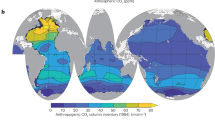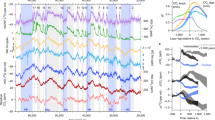Abstract
One of the greatest sources of uncertainty for future climate predictions is the response of the global carbon cycle to climate change1. Although approximately one-half of total CO2 emissions is at present taken up by combined land and ocean carbon reservoirs2, models predict a decline in future carbon uptake by these reservoirs, resulting in a positive carbon–climate feedback3. Several recent studies suggest that rates of carbon uptake by the land4,5,6 and ocean7,8,9,10 have remained constant or declined in recent decades. Other work, however, has called into question the reported decline11,12,13. Here we use global-scale atmospheric CO2 measurements, CO2 emission inventories and their full range of uncertainties to calculate changes in global CO2 sources and sinks during the past 50 years. Our mass balance analysis shows that net global carbon uptake has increased significantly by about 0.05 billion tonnes of carbon per year and that global carbon uptake doubled, from 2.4 ± 0.8 to 5.0 ± 0.9 billion tonnes per year, between 1960 and 2010. Therefore, it is very unlikely that both land and ocean carbon sinks have decreased on a global scale. Since 1959, approximately 350 billion tonnes of carbon have been emitted by humans to the atmosphere, of which about 55 per cent has moved into the land and oceans. Thus, identifying the mechanisms and locations responsible for increasing global carbon uptake remains a critical challenge in constraining the modern global carbon budget and predicting future carbon–climate interactions.
This is a preview of subscription content, access via your institution
Access options
Subscribe to this journal
Receive 51 print issues and online access
$199.00 per year
only $3.90 per issue
Buy this article
- Purchase on Springer Link
- Instant access to full article PDF
Prices may be subject to local taxes which are calculated during checkout


Similar content being viewed by others
References
Meehl, G. A. et al. in Climate Change 2007: The Physical Science Basis (eds Solomon, S. et al.) 792–802 (Cambridge Univ. Press, 2007)
Schimel, D. S. et al. Recent patterns and mechanisms of carbon exchange by terrestrial ecosystems. Nature 414, 169–172 (2001)
Friedlingstein, P. et al. Climate-carbon cycle feedback analysis: results from the C4MIP model intercomparison. J. Clim. 19, 3337–3353 (2006)
Pan, Y. et al. A large and persistent carbon sink in the world’s forests. Science 333, 988–993 (2011)
Piao, S. et al. Net carbon dioxide losses of northern ecosystems in response to autumn warming. Nature 451, 49–52 (2008)
Zhao, M. & Running, S. W. Drought-induced reduction in global terrestrial net primary production from 2000 through 2009. Science 329, 940–943 (2010)
McKinley, G. A., Fay, A. R., Takahashi, T. & Metzl, N. Convergence of atmospheric and North Atlantic carbon dioxide trends on multidecadal timescales. Nature Geosci. 4, 606–610 (2011)
Le Quéré, C. et al. Saturation of the Southern Ocean CO2 sink due to recent climate change. Science 316, 1735–1738 (2007)
Schuster, U. & Watson, A. J. A variable and decreasing sink for atmospheric CO2 in the North Atlantic. J. Geophys. Res. 112, C11006 (2007)
Le Quéré, C., Takahashi, T., Buitenhuis, E. T., Rödenbeck, C. & Sutherland, S. C. Impact of climate change and variability on the global oceanic sink of CO2 . Glob. Biogeochem. Cycles 24, GB4007 (2010)
Sarmiento, J. L. et al. Trends and regional distributions of land and ocean carbon sinks. Biogeosciences 7, 2351–2367 (2010)
Knorr, W. Is the airborne fraction of anthropogenic CO2 emissions increasing? Geophys. Res. Lett. 36, L21710 (2009)
Gloor, M., Sarmiento, J. L. & Gruber, N. What can be learned about carbon cycle climate feedbacks from the CO2 airborne fraction? Atmos. Chem. Phys. 10, 7739–7751 (2010)
Boden, T. A., Marland, G. & Andres, R. J. Global, regional, and national fossil-fuel CO2 emissions. Carbon Dioxide Information Analysis Centerhttp://cdiac.ornl.gov/trends/emis/overview.html (2010)
BP. Statistical Review of World Energy http://www.bp.com/sectionbodycopy.do?categoryId = 7500&contentId = 7068481 (2011)
European Commission. Emissions Database for Global Atmospheric Research (EDGAR). Europa - EDGAR Overviewhttp://edgar.jrc.ec.europa.eu/overview.php?v = 40 (2009)
Friedlingstein, P. et al. Update on CO2 emissions. Nature Geosci. 3, 811–812 (2010)
Stocker, B., Strassmann, K. & Joos, F. Sensitivity of Holocene atmospheric CO2 . Biogeosciences 7, 921–952 (2011)
Yang, X., Richardson, T. K. & Jain, A. K. Contributions of secondary forest and nitrogen dynamics to terrestrial carbon uptake. Biogeosciences 7, 3041–3050 (2010)
Marland, G., Hamal, K. & Jonas, M. How uncertain are estimates of CO2 emissions? J. Ind. Ecol. 13, 4–7 (2009)
Canadell, J. G. et al. Contributions to accelerating atmospheric CO2 growth from economic activity, carbon intensity, and efficiency of natural sinks. Proc. Natl Acad. Sci. USA 104, 18866–18870 (2007)
Le Quéré, C. et al. Trends in the sources and sinks of carbon dioxide. Nature Geosci. 2, 831–836 (2009)
Masarie, K. A. & Tans, P. P. Extension and integration of atmospheric carbon dioxide data into a globally consistent measurement record. J. Geophys. Res. 100, 11593–11610 (1995)
Keeling, C. D. et al. A three dimensional model of atmospheric CO2 transport based on observed winds: 1. Analysis of observational data. Geophys. Monogr. 55, 165–236 (1989)
Griffith, D. W. T., Keeling, C. D., Adams, J. A., Guenther, P. R. & Bacastow, R. B. Calculations of carrier gas effects in non-dispersive infrared analyzers. II. Comparisons with experiment. Tellus 34, 385–397 (1982)
Andrews, A. E. et al. Empirical age spectra for the midlatitude lower stratosphere from in situ observations of CO2: quantitative evidence for a subtropical barrier to horizontal transport. J. Geophys. Res. 106, 10257–10274 (2001)
Houghton, R. A. Revised estimates of the annual net flux of carbon to the atmosphere from changes in land use and land management 1850–2000. Tellus B 55, 378–390 (2003)
Acknowledgements
A.P.B. was supported by the US National Research Council and the US National Science Foundation. This manuscript benefitted from comments from J. Neff, N. Lovenduski and G. Marland. We also thank K. Masarie for performing the bootstrap calculations on the atmospheric CO2 sampling network. This work would not have been possible without the careful measurements made by scientists at NOAA ESRL and volunteer sample collectors throughout the world.
Author information
Authors and Affiliations
Contributions
All authors identified the need for this analysis. P.P.T. and J.B.M. contributed to the uncertainty analysis, and P.P.T. and A.P.B. devised the Monte Carlo simulations. A.P.B. and C.B.A. wrote the paper with assistance from all other co-authors.
Corresponding author
Ethics declarations
Competing interests
The authors declare no competing financial interests.
PowerPoint slides
Rights and permissions
About this article
Cite this article
Ballantyne, A., Alden, C., Miller, J. et al. Increase in observed net carbon dioxide uptake by land and oceans during the past 50 years. Nature 488, 70–72 (2012). https://doi.org/10.1038/nature11299
Received:
Accepted:
Published:
Issue Date:
DOI: https://doi.org/10.1038/nature11299
This article is cited by
-
Spatiotemporal atmospheric in-situ carbon dioxide data over the Indian sites-data perspective
Scientific Data (2024)
-
Recent decrease of the impact of tropical temperature on the carbon cycle linked to increased precipitation
Nature Communications (2023)
-
Evidence and attribution of the enhanced land carbon sink
Nature Reviews Earth & Environment (2023)
-
Decadal increase in groundwater inorganic carbon concentrations across Sweden
Communications Earth & Environment (2023)
-
Global increase in biomass carbon stock dominated by growth of northern young forests over past decade
Nature Geoscience (2023)
Comments
By submitting a comment you agree to abide by our Terms and Community Guidelines. If you find something abusive or that does not comply with our terms or guidelines please flag it as inappropriate.



